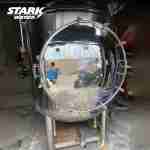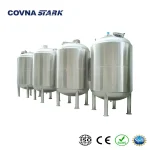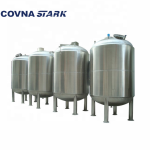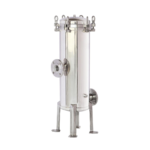Introduction: Food Safety Starts with Hygienic Water Storage
In the food and beverage industry, water isn’t just a utility—it’s a critical input that directly or indirectly comes into contact with consumable products. From ingredient mixing to equipment cleaning (CIP), the water used must be stored in conditions that meet strict hygiene and regulatory standards.
Yet many producers still rely on low-grade plastic or basic 304 stainless steel tanks, which are not always suitable for the chemical and microbial demands of modern food processes. Acidic ingredients, high-chloride content, and repeated cleaning cycles can all degrade tank surfaces, leading to product contamination or regulatory failure.
To ensure product safety, consistency, and long-term operational reliability, 316 or 316L stainless steel has become the preferred material for hygienic water tanks in food and beverage manufacturing. In this article, we’ll explain why, and how STARK’s 316L tank solutions are built for the job.
Why 316 Stainless Steel Is Preferred Over 304 in Food Applications
While both 304 and 316 stainless steel are commonly used in industrial fabrication, they differ significantly in terms of chemical composition and corrosion resistance—especially in food and beverage environments.
Key Differences That Matter:
- Molybdenum Content: 316 contains 2–3% molybdenum, which significantly improves its resistance to chlorides, acids, and saline solutions commonly found in sauces, dairy, and fruit-based beverages.
- Acidic and Low-pH Resistance: 316 tanks perform far better than 304 when storing acidic liquids such as citrus-based drinks, vinegar mixtures, or tomato products.
- CIP and Steam Compatibility: 316L withstands frequent cleaning with hot water, chemicals, and steam sterilization without pitting or crevice corrosion.
- Regulatory Acceptance: Many hygiene-critical certifications (e.g., 3-A, FDA) recognize 316 as the preferred material for food-contact surfaces under demanding conditions.
Although 304 may suffice in neutral environments, it becomes a liability in processes that involve acidity, high salinity, or repeated sanitization. Choosing 316 means investing in food safety, longevity, and regulatory peace of mind.
Key Features of STARK 316 Stainless Steel Water Tanks for Food Use
STARK’s food-grade water tanks are engineered to meet the hygienic, operational, and regulatory demands of modern food and beverage production. Built with certified SUS316 or SUS316L stainless steel, these tanks are customizable for volume, configuration, and integration into automated process lines.
Highlights of Our 316L Tank Solutions:
- Hygienic Construction: Internal surfaces polished to Ra ≤ 0.4 μm (mechanical or electropolished) for superior cleanability and biofilm resistance.
- Sanitary Design: Sloped bottom for full drainability, CIP spray ball, tri-clamp ports, and food-grade valves.
- Pressure & Temperature Tolerance: Designed to withstand CIP (Clean-in-Place), SIP (Steam-in-Place), and thermal cycling in high-temperature environments.
- Custom Volumes: Available from 300L to 10,000L+, vertical or horizontal installation.
- Documentation Ready: Supplied with FDA-grade gasket certificates, EN10204 3.1 material reports, and optional weld maps or passivation validation.
- Integrated Process Support: Optional level sensors, insulation layers, mixers, or PLC I/O interfaces for process automation.
Our tanks are trusted by food processors handling juice, syrup, sauces, dairy water, rinse water, and CIP system return water—where hygiene and reliability are non-negotiable.
View our featured tank series for food and beverage applications:
STARK 316L Sterile Water Tank
Common Applications in Food and Beverage Production
316L stainless steel water tanks are widely used across various stages of food and beverage manufacturing due to their durability, hygiene compliance, and resistance to corrosion and cleaning agents. Below are the most common use cases where STARK tanks have been implemented:
- Ingredient Water Storage: Storage of pre-treated or RO-purified water used in product formulation, flavor dilution, or syrup mixing.
- Juice and Beverage Blending: As temporary holding or mixing tanks for acidic liquids such as citrus concentrates or fruit infusions, where corrosion resistance is critical.
- Dairy and Rinse Water Applications: Suitable for storing milk pre-processing water, rinse cycles, or water used for cleaning filling and packaging lines.
- CIP System Water Tanks: Tanks integrated into Clean-in-Place (CIP) systems to store alkaline, acidic, or neutral cleaning solutions and return water for reuse.
- Cooling and Buffer Water: Holding water used in heat exchangers or for thermal buffering during batch production or temperature-sensitive bottling operations.
- Fermentation Process Support: In fermentation-based beverage production (e.g., kombucha or low-alcohol brews), these tanks act as sanitary water carriers or buffer tanks between steps.
In all these scenarios, using 316L stainless steel ensures that hygiene, taste integrity, and system reliability are preserved throughout the production process. The tanks’ versatility also allows them to be integrated into automated lines with sensors and remote monitoring systems.
Case Study – A Beverage Manufacturer’s Upgrade to 316
A regional fruit beverage company was facing repeated product quality complaints and increased internal cleaning time. Their existing setup used 304 stainless steel tanks for citrus-based syrup blending and RO water storage. After just 18 months, visible pitting corrosion was detected, and microbial swabs showed elevated bacteria counts inside weld seams and the outlet piping.
Additionally, during a third-party food safety audit, the tanks failed to meet the facility’s hygiene validation standards due to lack of complete drainage and insufficient documentation on weld passivation.
STARK Solution: The company replaced two tanks with custom-built SUS316L vertical water tanks featuring:
- Electropolished interior (Ra ≤ 0.4 μm)
- CIP spray ball, sterile breather valve, and tri-clamp sampling port
- Sloped conical bottom for zero retention and easy drainability
- Documentation package with 3.1 material certificate and weld map
Results within 6 weeks of installation:
- ✔ Passed food safety re-inspection with zero corrective actions
- ✔ Reduced weekly tank cleaning time by 45%
- ✔ Extended batch shelf life by improving hygiene stability
- ✔ Re-established confidence with international distribution partners
This case highlights how switching to the right tank material and construction not only solves hygiene and durability issues but also strengthens the brand’s food safety reputation.
Conclusion – For Food Safety and Long-Term Value, Choose 316
In the food and beverage industry, water tank selection is not just a question of cost—it’s a matter of product integrity, hygiene compliance, and operational efficiency. While 304 stainless steel may suffice in basic environments, the risks of corrosion, bacterial retention, and audit failure are real in acidic or high-demand processes.
316 and 316L stainless steel, with their enhanced corrosion resistance and hygienic performance, have become the material of choice for food-grade storage across juice, dairy, brewing, and packaging operations. A well-designed 316L tank helps you meet international standards, streamline cleaning routines, and build long-term consumer trust.
STARK’s 316 stainless steel tanks are engineered with sanitation, durability, and documentation in mind—giving you full support from design to delivery and beyond.
Need a certified 316L tank for your food production line?
Contact our engineering team
for technical advice, drawings, or a tailored quote.





